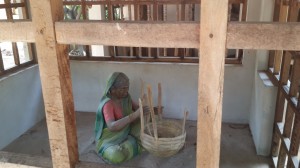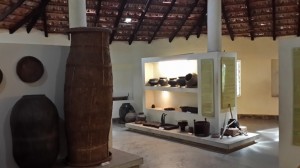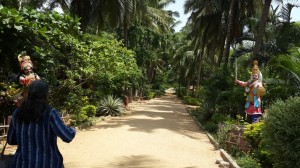 Janapada Loka … a trip down memory lane – Hema Iyer Ramani
Janapada Loka … a trip down memory lane – Hema Iyer Ramani
“In the great cities we see so little of the world, we drift into our minority. In the little towns and villages there are no minorities; people are not numerous enough. You must see the world there, perforce. Every man is himself a class; every hour carries its new challenge. When you pass the inn at the end of the village you leave your favourite whimsy behind you; for you will meet no one who can share it. We listen to eloquent speaking, read books and write them, settle all the affairs of the universe. ……The ancient map-makers wrote across unexplored regions, ‘Here are lions.’ Across the villages of fishermen and turners of the earth, so different are these from us, we can write but one line that is certain, ‘Here are ghosts.’ (“Village Ghosts”)”
W.B.Yeats, The Celtic Twilight:Faerie and Folklore.
 Life often is like that. We breeze through our youth rushing past ,without noticing things around us. When we move into the cities, our villages become only memories that trail behind. We carry these ‘ghosts’ and try to understand them only when we are well past our prime. With the passing of time, cultural memories get hidden and lost unless they find their way into books or museums.
Life often is like that. We breeze through our youth rushing past ,without noticing things around us. When we move into the cities, our villages become only memories that trail behind. We carry these ‘ghosts’ and try to understand them only when we are well past our prime. With the passing of time, cultural memories get hidden and lost unless they find their way into books or museums.
It was one such dream of a single man called Nage Gowda(Senior Bureaucrat)to keep alive folk traditions concentrated and afresh within 15 acres of land . 53 kilometres away from Bengaluru, on the way to Mysore in Ramnagara district is the beautiful folk village museum called Janapada Loka. An imposing gateway with metal work of trumpets , horns and harige(shield) that adorn it immediately holds the attention of the viewer. As soon as you walk through the gateway, you are greeted by massive Nandidwajas standing tall and majestic on either side of the pathway. The lush greenery is instantly soothing to the eyes, and it does not seem too difficult to walk across the long stretch of land, for there are stone benches all around and winding pathways with tiny shelters where you could halt and rest before proceeding to different museums. The monkeys and the geese kept us company as we sauntered ahead.
 Our first stop was at the Lokamata Mandira , where a variety of household utensils and agricultural tools that were in use in rural Karnataka are in display. A folk artiste( clad in trousers and shirt)took us around explaining the purpose and function of each of them, and we found we were actually familiar with some of them in our own grandparents’ homes- grinding stones, coconut graters, saavige(sevai) maker, and so on. Tall urns that towered over us were used to store ragi, the staple food .Seeing our sincere interest, he went on talk about folksongs, and we discovered just how talented he was when we heard his magical, deep-throated voice reverberate across the area. All that talk of grains and millets , the food, the way it was cooked soon made us hungry. We soon headed to the Lokaruchi Upahara Mandira. Traditional food was served on plantain leaves-delicacies hitherto forgotten except in some traditional homes, where closely guarded secrets lay hidden and tucked away. Kadubu idli wrapped in plantain leaf, mango pulp saaru, Ragi mudde, jolada rotti and akki rotti to mention a few. I recalled eating piping hot ragi mudde once long back. It was served on a plate with a stone underneath. Saaru would be poured , wetting the mudde just lightly but not keeping it spongy. It reminded me of the coffee plant grown on slopes- it needs water , but not stagnant .
Our first stop was at the Lokamata Mandira , where a variety of household utensils and agricultural tools that were in use in rural Karnataka are in display. A folk artiste( clad in trousers and shirt)took us around explaining the purpose and function of each of them, and we found we were actually familiar with some of them in our own grandparents’ homes- grinding stones, coconut graters, saavige(sevai) maker, and so on. Tall urns that towered over us were used to store ragi, the staple food .Seeing our sincere interest, he went on talk about folksongs, and we discovered just how talented he was when we heard his magical, deep-throated voice reverberate across the area. All that talk of grains and millets , the food, the way it was cooked soon made us hungry. We soon headed to the Lokaruchi Upahara Mandira. Traditional food was served on plantain leaves-delicacies hitherto forgotten except in some traditional homes, where closely guarded secrets lay hidden and tucked away. Kadubu idli wrapped in plantain leaf, mango pulp saaru, Ragi mudde, jolada rotti and akki rotti to mention a few. I recalled eating piping hot ragi mudde once long back. It was served on a plate with a stone underneath. Saaru would be poured , wetting the mudde just lightly but not keeping it spongy. It reminded me of the coffee plant grown on slopes- it needs water , but not stagnant .
Here mudde was served hot with a dollop of ghee poured generously. The speciality of eating a mudde is you dip it ever so lightly in saaru and eat it hot, swallowing little balls , one at a time. A very popular dish among the village folks, not so much because it is a delicacy, but because it is extremely nutritious and was the farmer’s manna, something that was easily available and very inexpensive. In fact, landlords who had to serve food on estates to their employees fed them mudde because the workers could toil hard for long hours with the mudde sitting comfortably in their stomachs.
There was definitely a sense of déjà vu as one gobbled the mudde. But I felt I would have enjoyed the perfect scenario where I had to sit cross-legged in front of my plantain leaf served on a mane( small wooden seat) instead o the hard wooden chair that I had sat on.
Of course, once you eat the mudde, you have no option but to start the walk around the folk museum to digest the stubborn mudde ! Mudde thara koothir beda (don’t sit like mudde ) must have originated thus to prod people to toil so that it would digest.
We sauntered to the part where the prized artefacts were stored. Loka Mahal was truly impressive with its large collection of artefacts-large dolls of Yakshanagana and Garudi artistes, Kodava couple, a life-like bullock, leather puppets, war drums that when it was beaten produced the most powerful sound transporting us to a different time altogether.
The place has a beautiful amphi-theatre as well, where performances are staged on specific days. What was disappointing was the sight of the completely dry lake ,which explained as to why the geese kept walking all around the place and literally led us to a wild-goose chase toward the non-existent lake ! What is interesting however is that on the banks of the lake is housed a well equipped library that encourages students to re-search folk traditions: Janapada Loka offers certificates/diplomas recognized by the Bangalore University.
Life size dolls and animals depict the rural life style in an open court yard, where pottery is also demonstrated by artistes. Of course it would be impractical to uproot a village and bring it here. Besides the agricultural implements, what did fascinate me was also the beautifully carved chariot in wood that was so strategically placed that you had to instantly stop before you proceeded any further.
We were fascinated by the Dodda Mane: it seemed to be fashioned after old village homes in rural Karnataka, with a central courtyard, exuding stark simplicity that one would associate with folk traditions. Dodda Mane lets out its space for people to conduct their weddings- a destination wedding amidst mango and flowering trees, with chirping birds certainly sounds like a dream, for people who have lost all their ‘roots’ with their native villages. The place also serves to house all folk artistes visiting and staying at Janapada Loka.
Janapada Loka….a haven , where you reconnect to your roots and find resonance with your cultural history.
( A former lecturer of Political Science at Mount Carmel College,Bangalore , Chennai-based writer Hemalatha Ramani contributes to newspapers,magazines and blogs.She is the author of a travel book, Soulscapes:Travels and Conversations in India) She writes under the name of Hema Iyer Ramani.

